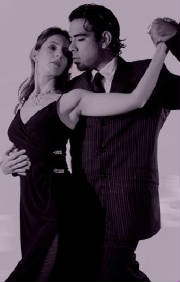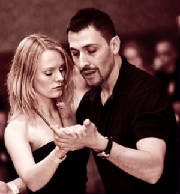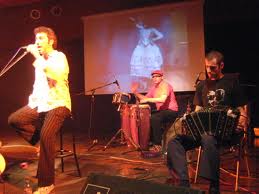Review: England International Tango Festival 2012... Two: Classes
5th June 2012
Introduction | Workshop Notes: Part One | Workshop Notes: Part Two | Dancing and Conclusion
Introduction
After getting here and settling in, this entry will be a review of the classes I attended on Saturday 2nd June and Sunday 3rd June. Basically this is a set of my class notes, but hopefully it'll make sense to others as well as myself...
Saturday workshops
These are notes for classes I attended on Saturday, 2nd June.
Workshop: Tango Bootcamp (Mike and Sue)
In the morning, I went to part of the Tango Bootcamp - a mid-morning session introducing ochos via back ochos. The session (and Bootcamp in general) was taught by Mike and Sue.
We used a standard side-transfer-side sequence to get started out, then we put that sequence in the dancing.
It was nicely taught, the pace was quite slow, which allowed everyone to get it.
One thing I learnt was the need to emphasize to the followers that they should take their time over the step, and (especially) over the collection, as everyone seemed to rush these, probably because they thought it would help their balance.
Mike also made a good point about the pivotting during the weight transfer - it's a continuation of the movement and so provides the feeling of continuous movement, I'd not really thought of it in that way before.
Workshop: Combinations for Close Embrace in Tight Spaces (adv)

Teachers: Dario and Clare Da Silva
The theme for this workshop was about using combinations and turns in a close embrace, designed for a ctowded environment. So ideal for the Saturday night really :)
We did two sequences:
- A cadencia in crossed system
- A rotating sequence
The cadencia variation involved:
- Man sidestep left, change weight (woman sidesteps, no weight change)
- Man does a standard cadencia sequence (rock forwards and back, then sidestep)
- Woman rocks back and forwards, then pivots and steps in a back ocho
We did a variation of this one, with a back-cross instead of a back ocho (achieved by the man not pivotting)
It was a lovely variation of a standard step, and I'll definitely use that in future.
We also did a "cut back-step" sequence, where the man did a forward-side-back sequence whilst the woman did a rebound then forwards ocho, but I didn't quite absorb that version.
Still, one excellent sequence is a bonus - and I practiced and used that in freestyles, so hopefully I'll retain that one.
Sunday workshops
Workshop: Traditional Tango with Modern Technique Masterclass
Teachers: Joel Daou & Alina Kolonitskaya

(Note: I only did the first half of this masterclass - it was in two linked 90-minute sessions).
We did a nice warmup, with some exercises including rising and lowering on our heels.
We spent some time on pure technique, focussing on "two points on our chest". No, not those two. Basically it was a dissociation exercise, as we projected our leg backwards we projected the equivalent point on our chest forwards. We did this exercise for both forwards and backwards movements.
Note: This natural dissociation does not work in a crossed system.
Some technique points
- Don't "stomp" the heel downwards, keep the weight change gradual and avoid putting all your weight on the heel.
- When taking a step, you "flex" (lower)
- Ladies head position - keep it in line with the body (vertebrae) rather than twist it.
- Men: keep the hip back as much as possible when walking forwards - engage the bum muscles basically
Talked about the circularity of the embrace - creating a circle movement with your arms. Use a gym ball!
We looked at several sequences using crossed systems:
- Sequence 1: Walk in crossed system, then both cross together (man crosses left behind right) to keep in crossed system
- Sequence 2: Same as above, but turn it into a circular (anti-clockwise) movement
- Sequence 3: add a sacada at the end of the movement
We then looked at several ocho-based sequences:
- Sequence 1: Travelling ochos - less angles with forward walking
- Sequence 2: Travelling ochos with a rebound
A technique point for women in back ochos; the Inner part of big toe touches floor first, makes it look much nicer
Joel and Alina emphasized that the technique for ochos is a large part (80% in their estimate) of the general technique for tango overall
I liked the cross-based sequence. I think I liked the ocho based rebound one, but I'll need to work on that to ensure it makes sense to me. As always, it'll be a question of practicing to ensure I retain these concepts and movements.
Workshop: Leaders Technique & Styling
Teacher: Dario Da Silva

Dario's tango guide for leaders. Packed with tips on how to improve your posture and lead. Essential advice+ exercises on how to develop a more flowing elegant walk and to use your walk to dance much more musically. Finally Dario's secrets on how to be more in demand + desirable as a leader in the milonga.
More desirable, wooo! :)
OK, so maybe a little overhyped, there... But it certainly put us through our paces.
We started with our posture - leaning forwards until our toes curled, then leaning back just enough to uncurl them - this was the optimum position, and it's a great exercise to determine the correct posture.
Keep the feet pointing outwards in a slight V shape (at 5 to 11).
We did a salida lead (step left), with toes pointing out again, and working to collect feet with one slightly behind the other.
Balance tips:
- Exhale for balance (brings the centre downwards).
- Keep your upper body still
We then spent some time walking. Here's some walking tips:
- Don't throw your feet in front of yourself; you're the engine at the front of the car, not the boot
- Don't wave your arms around when walking by yourself - your partner will be in front of you
- Each step is a controlled risk - you have to go for it, commit to the fall within the step
We had a little debate about whether La pisada (step) should be heel-toe or toe-heel. Overall, it seems to be that more people are coming around to the toe-heel side of the debate, but the argument will, no doubt, continue...
Next, we looked at pivotting, using forward ochos.
Some ocho tips:
- Pivots happen because the upper body rotates. The pivot happens from the upper body, the lower body and legs follow.
- Pivot on the ball of the foot - the heel is the brake
We finished off with a couple of decorations based around a lapis movement: circling the foot behind, then in front, then step (foot movement must not be shown in the upper body), then extended this decoration with a change of direction.
Overall, the workshop was very hard work - more so than any other I attended, because it was so constant, the focus was always on us. But I learnt a lot.
Workshop: "Tango Music and Musicality" - with Otros Aires
Now this was a real treat.
Teacher: Miguel

We had the band, Otros Aires, give us a lesson in musicality. The lead singer, Miguel, talked through some basics of musical phrases and rhtyhms (Marcatto, Pesante, Sincopa, Yumba, 332), and then explained how to dance more musically to them.
Each explanation was given with live illustrations from the band. So you had the lead singer tell us something, and the band would then play that rhythm. Fantastic - a genuinely unique experience, I can't remember attending anything quite like it.
I especially liked the "Yumba" description. It's very difficult to describe the workshop, because it largely involved listening to the music and Miguel, but I certainly gained an appreciation for some of the depths of musicality that I'll need to learn.
Miguel was engaging, funny, and of course highly authoritative. For sheer enjoyment, the workshop with Otros Aires would be difficult to beat.
~ David Bailey, 5th June 2012